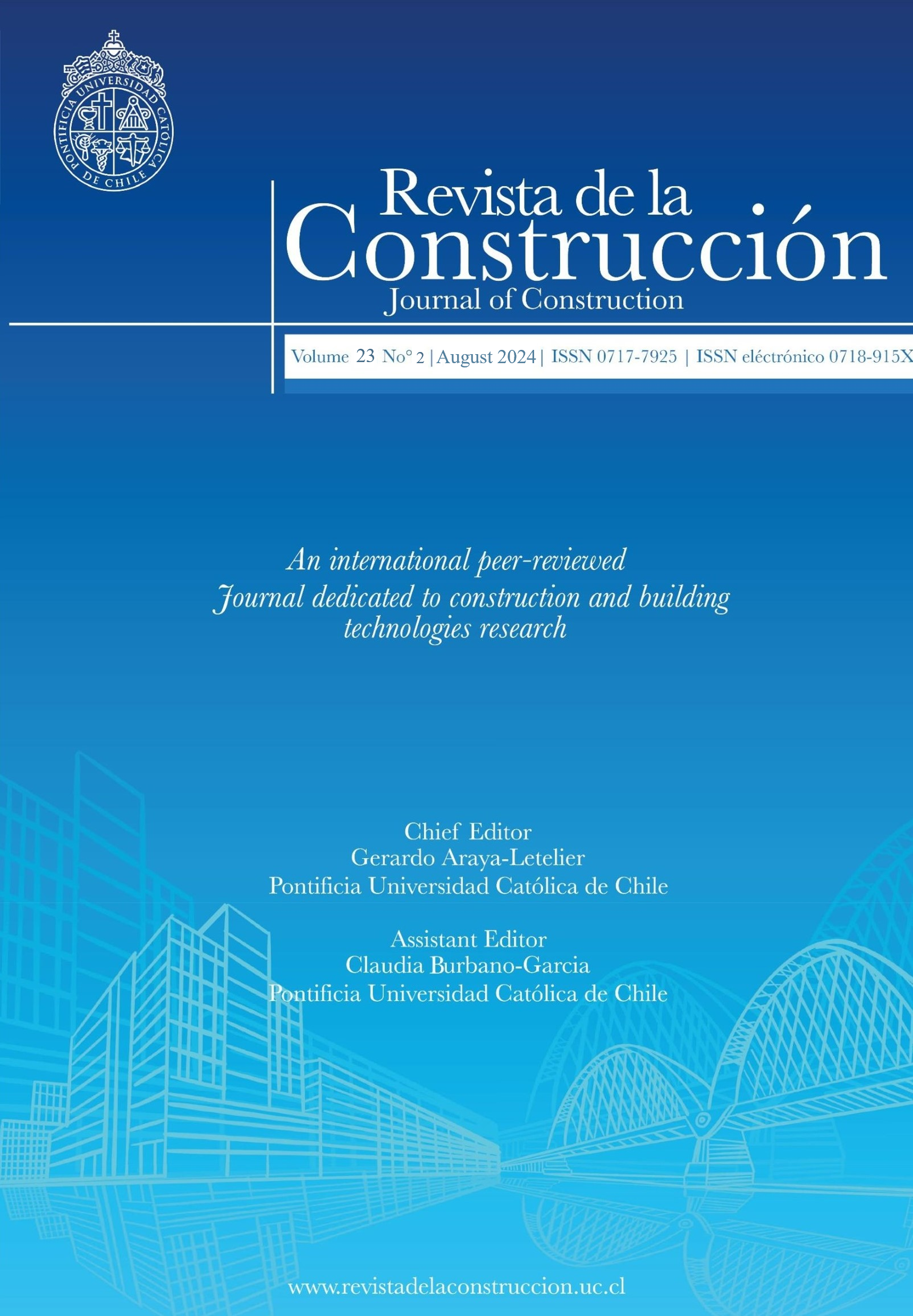Heavy aggregate and different admixtures efffect on parquets: chrome, magnetite, and quartz-based surface hardener
DOI:
https://doi.org/10.7764/RDLC.23.2.230Keywords:
Chromite aggregate, magnetite aggregate, surface abrasion resistance, SEM.Abstract
This paper presents the mechanical and micro-structure results of concrete parquet blocks. The blocks were generated by utilizing the same part in the bottom part and by substituting different proportions (40%, 30%, 20%, and 10%) of heavy aggregate like chromite aggregate, magnetite aggregate, normal aggregate, and surface hardener in the upper part. The parquet sample tests were conducted on TS 2824 EN 1338. The test outcomes indicated that utilizing diverse aggregate and chemical materials boosted the abrasion resistance, 40% magnetite and quartz-based concrete parquet block samples demonstrated the best abrasion resistance values. Also, the minimum amount of mass loss was discovered in the samples that possess high water absorption at the freezing-thaw test. The different material substitutions in the sheet of the surface of the concrete parquet block samples altered the tensile strength of the samples, even though they did not bring about an outstanding variation in the compressive strength of the concrete parquet samples.
Downloads
References
Açıkgöz, Y. (2008). Investigation of the Use of Fly Ash in the Production of Concrete Interlocking Pavers, Master Thesis, Gazi University, Ankara, Turkey, 57 p., 61.
ACI 302.1R-15 (2015). Guide to Concrete Floor and Slab Construction, American Concrete Institute.
ASTM C 936-01 (2001). Standart specification for solid concrete interlocking paving units. American Society for Testing and Materials, Philadelphia, PA.
Baradan, B. ve Felekoğlu, B. (2004). Mechanical Properties of Self-Compacting Concretes, Turkish Ready-Mixed Concrete Journal, No. 222.
BS 8204-1 2003+A1 (2009). Screeds, bases and in situ floorings. Concrete bases and cementitious levelling screeds to receive floorings. Code of practice, Standard of BSI Group.
Canpolat, H. (2018). Use of Production Kayseri Zinc-Lead Production Facility Wastes in Concrete Paving Stones, Master Thesis, Erciyes University, Kayseri, Turkey, 46 p., 52.
Cimen, O. (2015). Investigation of the Use of Rebound Material as Paving Stone in Shotcrete Application, Master Thesis, Süleyman Demirel University, Institute of Science, Isparta, 11-12 p., 93.
Corinaldesi, V., and Moriconi G. (2004). Durable fiber reinforced selfcompacting concrete. Cement and Concrete Research, Vol. 34 pp. 249-254.
Abu el‐Hassan, K., Hakeem, I. Y., Amin, M., Tayeh, B. A., Zeyad, A. M., Agwa, I. S., & Elsakhawy, Y. (2024). Effects of nano titanium and nano silica on high‐strength concrete properties incorporating heavyweight aggregate. Structural Concrete, 25(1), 239-264.
Karpuz, O. ve Akpınar, M.V. (2009). Effect of Fine Aggregate Type on Abrasion Resistance of Coating Concrete, Electronic Journal of Construction Technologies, 5 (2), 1-8. In Turkish.
Kumar, R. (2017). Influence of recycled coarse aggregate derived from construction and demolition waste (CDW) on abrasion resistance of pavement concrete. Construction and Building Materials, 142, 248-255.
Lumingkewas, R. H., Hadiwardoyo, S. P., & Hadiwardoyo, F. A. (2023). Laboratory Innovation to Investigate Concrete Paving Blocks Compressive Strength. Civil Engineering Journal, 9(11), 2672-2688. 10.28991/CEJ-2023-09-11-03
Özalp, F., Yılmaz, H., Kara, M., Kaya, Ö. ve Sahin, A. (2016). Effects of recycled aggregates from construction and demolition wastes on mechanical and permeability properties of paving stone, kerb and concrete pipes. Construction and Building Materials, 110, 17–23.
TS EN 206-1 (2002). Concrete - property, performance, fabrication and suitability. TSE., Ankara.
TS 2824 EN 1338 (2005). Concrete Paving Blocks for Flooring – Requirements and Test Methods. TSE., Ankara.
TS EN 12390-3 (2010). Concrete - Hardened Concrete Tests - Chapter 3: Determination of Compressive Strength of Test Samples, TSE., Ankara.
URL-1 (2006). www.imo.org.tr/resimler/ekutuphane/pdf/11224.pdf (27 Ekim 2022).In Turkish.
TS EN 934-2 (2002). Chemical Admixtures- for concrete, mortar, and juice – Chapter 2: Chemical Admixtures - Definitions, specifications, conformity, marking and labeling. TSE., Ankara.
Ustabas, I., Demirci, M., Baltas, H., Demir, . Y., Erdogdu, S., Kurt, Z., Cakmak, T. (2022). Mechanical and radiation attenuation properties of conventional and heavy concrete with diverse aggregate and water/cement ratios, GRAĐEVINAR, 74 (8), 635-645, doi: https://doi.org/10.14256/JCE.3382.2021
Uygunoğlu, T., Topcu, İ.B., Gencel, O. ve Brostow, W. (2012). The effect of fly ash content and types of aggregates on the properties of pre-fabricated concrete interlocking blocks (PCIBs), Construction and Building Materials, 30, 180–187.
Sahbaz, A. (2010). The Effect of Different Natural Stone Aggregates, Concrete Blocks and Interlocking Paving Stone on the Physico-Mechanical Properties, Master Thesis, Afyon Kocatepe University, Institute of Science, Afyonkarahisar, Turkey, 142 p., 156.
Teymen, A. (2023). Statistical investigation of the effects of different origin aggregate properties on the mechanical properties of concrete. Revista de la construcción, 22(2), 482-508.
Topçu, I.B. ve Canbaz, M. (2004). Properties of concrete containing waste glass. Cement and Concrete Research, 34, 267-274.
Yahlizade, E.S. (2007). Investigation of Fire, Freeze-Thaw and Abrasion Resistance of Paving Stones Containing Waste Glass, Master Thesis, Harran University, Şanlıurfa, 21 p., 25.
Yıldız, I. (2013). Investigation of the Usability of Elazig Ferrochrome Slag in Concrete Paving Stone and Brick Production, Doctoral Thesis, Atatürk University, Institute of Science, Erzurum, 190 p., 206.
Yavasi, H. (2018). Determination of Mechanical and Radiation Absorption Properties of Ground Pyrite, Chromium and Magnetite Added Mortars. Master Thesis. Recep Tayyip Erdoğan University, Institute of Science, Rize, Türkiye, 49 p., 18.
Downloads
Published
How to Cite
Issue
Section
License
Copyright (c) 2024 Ilker Ustabas, Sakir Erdogdu, Mustafa Ucok, Zafer Kurt, Talip Cakmak

This work is licensed under a Creative Commons Attribution-NonCommercial-NoDerivatives 4.0 International License.








